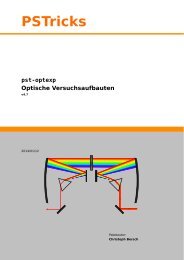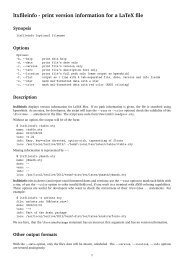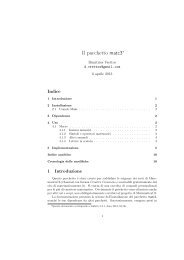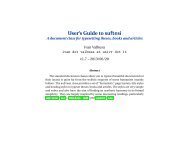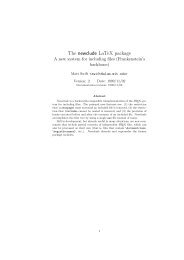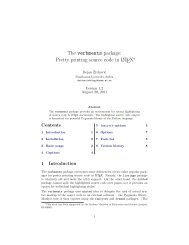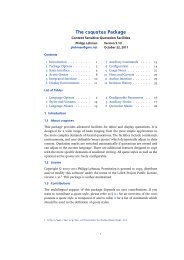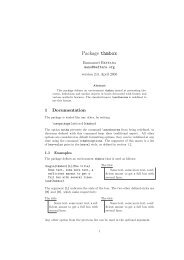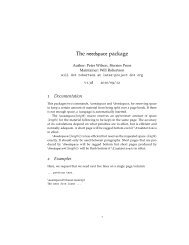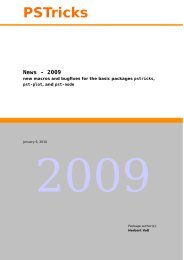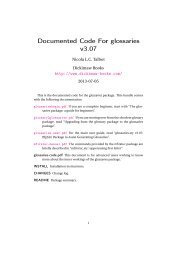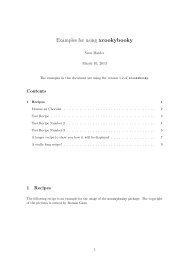Create successful ePaper yourself
Turn your PDF publications into a flip-book with our unique Google optimized e-Paper software.
The \eqindent and \eqnumside variables need to have their values initialized<br />
from context, actually. But that takes a bit of work, which is postponed till later.<br />
181 \def\eqindent{C}% % C or I, centered or indented<br />
182 \def\eqnumside{R}% % R or L, right or left<br />
183 \def\eqnumplace{M}% % M or T or B, middle top or bottom<br />
Typesetting the equation number is done thus:<br />
{\eqnumcolor \eqnumsize \eqnumfont{\eqnumform{\eq@number}}}<br />
.<br />
184 %d\eqnumfont{\upshape}% % Upright even when surrounding text is slanted<br />
185 \def\eqnumfont{}% % Null for easier debugging [mjd,1997/09/26]<br />
186 \def\eqnumform#1{(#1\@@italiccorr)} % Add parens<br />
187 \def\eqnumsize{} % Allow numbers to have different typesize ...<br />
Tricky questions on \eqnumsize. Should the default be \normalsize? Then the<br />
user can scale down the equation body with \small and not affect the equation<br />
number. Or should the default be empty? Then in large sections of smaller text,<br />
like the dangerous bend stuff in TEXbook, the equation number size will keep in<br />
synch with the context. Maybe need an \eqbodysize param as well to allow<br />
separating the two cases.<br />
188 \def\eqnumcolor{} % ... or color than eq body e.g. \color{blue}<br />
189 \newlength\eqlinespacing \eqlinespacing=14pt plus2pt % Base-to-base space between lines<br />
190 \newlength\eqlineskip \eqlineskip=3pt plus2pt % Min space if eqlinespacing too small<br />
191 \newdimen\eqlineskiplimit \eqlineskiplimit=2pt % Threshold for switching to eqlineskip<br />
The value of \eqbinoffset should include a negative shrink component that<br />
cancels the shrink component of medmuskip, otherwise there can be a noticeable<br />
variation in the indent of adjacent lines if one is shrunken a lot and the other isn’t.<br />
192 \newmuskip \eqbinoffset \eqbinoffset=15mu minus-3mu % Offset from mathrel alignment pt for mathb<br />
193 \newmuskip\eqdelimoffset \eqdelimoffset=2mu % Additional offset for break inside delims<br />
194 \newdimen\eqindentstep \eqindentstep=8pt % Indent used when LHS wd is n/a or too large<br />
195 \newtoks\eqstyle % Customization hook<br />
196 \newcount\eqbreakdepth \eqbreakdepth=2 % Allow breaks within delimiters to this depth<br />
197 \newcount \eqinterlinepenalty \eqinterlinepenalty=10000 % No page breaks between equation lines<br />
198 \newcount \intereqpenalty \intereqpenalty=1000 % Pagebreak penalty between equations [BRM: Was<br />
199 \newlength \intereqskip \intereqskip=3pt plus2pt % Additional vert space between equations<br />
200 \newcount\prerelpenalty \prerelpenalty=-\@M % Linebreak penalty before mathrel symbols<br />
201 \newcount\prebinoppenalty \prebinoppenalty=888 % Linebreak penalty before mathbins<br />
When breaking equations we never right-justify, so a stretch component of the<br />
muskip is never helpful and sometimes it is definitely undesirable. Note that thick/<br />
medmuskips frozen inside a fraction or radical may turn out noticeably larger than<br />
neighboring unfrozen ones. Nonetheless I think this way is the best compromise<br />
short of a new TEX that can make those built-up objects shrink horizontally in<br />
proportion; the alternative is to pretty much eliminate the shrink possibility completely<br />
in displays.<br />
202 \newmuskip \Dmedmuskip \Dmedmuskip=4mu minus 3mu % medmuskip in displays<br />
203 \newmuskip \Dthickmuskip \Dthickmuskip=5mu minus 2mu % thickmuskip in displays<br />
24



